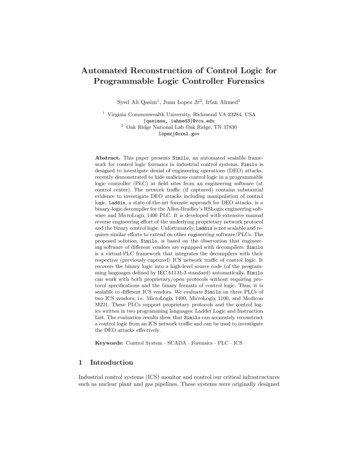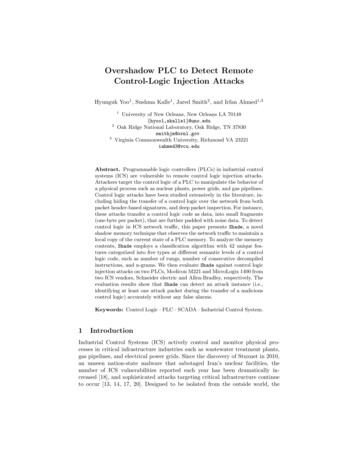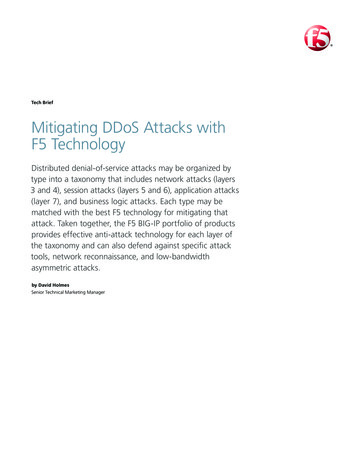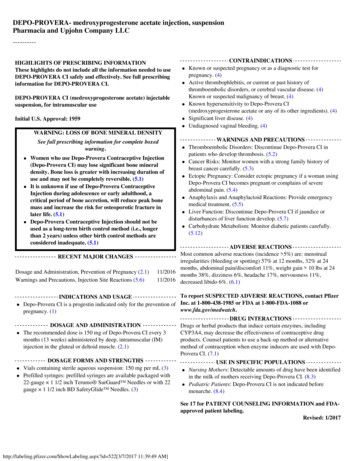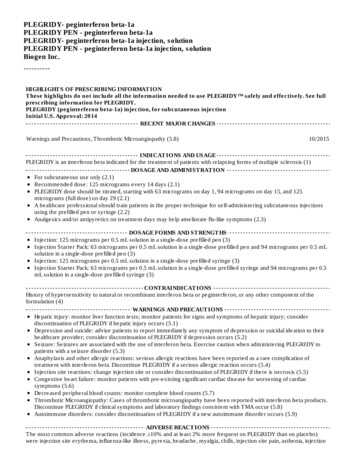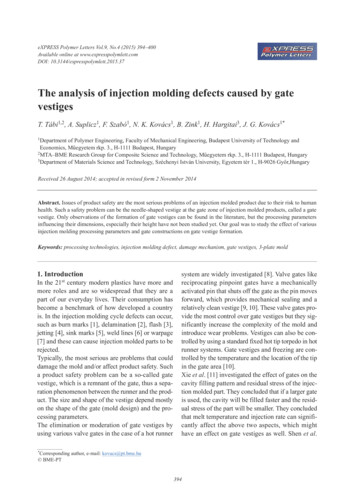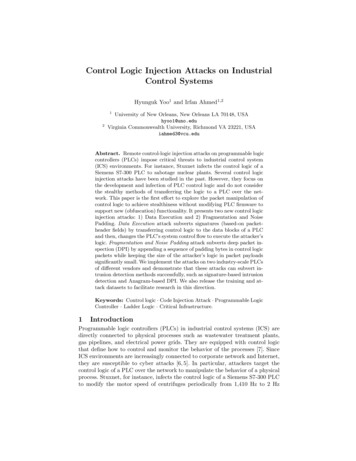
Transcription
Control Logic Injection Attacks on IndustrialControl SystemsHyunguk Yoo1 and Irfan Ahmed1,212University of New Orleans, New Orleans LA 70148, USAhyoo1@uno.eduVirginia Commonwealth University, Richmond VA 23221, USAiahmed3@vcu.eduAbstract. Remote control-logic injection attacks on programmable logiccontrollers (PLCs) impose critical threats to industrial control system(ICS) environments. For instance, Stuxnet infects the control logic of aSiemens S7-300 PLC to sabotage nuclear plants. Several control logicinjection attacks have been studied in the past. However, they focus onthe development and infection of PLC control logic and do not considerthe stealthy methods of transferring the logic to a PLC over the network. This paper is the first effort to explore the packet manipulation ofcontrol logic to achieve stealthiness without modifying PLC firmware tosupport new (obfuscation) functionality. It presents two new control logicinjection attacks: 1) Data Execution and 2) Fragmentation and NoisePadding. Data Execution attack subverts signatures (based-on packetheader fields) by transferring control logic to the data blocks of a PLCand then, changes the PLC’s system control flow to execute the attacker’slogic. Fragmentation and Noise Padding attack subverts deep packet inspection (DPI) by appending a sequence of padding bytes in control logicpackets while keeping the size of the attacker’s logic in packet payloadssignificantly small. We implement the attacks on two industry-scale PLCsof different vendors and demonstrate that these attacks can subvert intrusion detection methods successfully, such as signature-based intrusiondetection and Anagram-based DPI. We also release the training and attack datasets to facilitate research in this direction.Keywords: Control logic · Code Injection Attack · Programmable LogicController · Ladder Logic · Critical Infrastructure.1IntroductionProgrammable logic controllers (PLCs) in industrial control systems (ICS) aredirectly connected to physical processes such as wastewater treatment plants,gas pipelines, and electrical power grids. They are equipped with control logicthat define how to control and monitor the behavior of the processes [7]. SinceICS environments are increasingly connected to corporate network and Internet,they are susceptible to cyber attacks [6, 5]. In particular, attackers target thecontrol logic of a PLC over the network to manipulate the behavior of a physicalprocess. Stuxnet, for instance, infects the control logic of a Siemens S7-300 PLCto modify the motor speed of centrifuges periodically from 1,410 Hz to 2 Hz
2Yoo et al.to 1,064 Hz and then over again. Since the discovery of Stuxnet in 2010, whichsabotaged Iran’s nuclear facilities, the number of ICS vulnerabilities reportedeach year has been dramatically increased [1].To develop defensive solutions for control logic injection attacks, it is requiredto explore new attack vectors that target the control logic of a PLC to sabotagea physical process. In the past, different types of control logic injection attackshave been studied [9, 16, 15, 12]. For instance, the analysis of Stuxnet reveals thatit compromises the STEP 7 engineering software in a control center to establishthe communication with a target PLC in a field site and then transfers a prebuiltmalicious control logic to the PLC. These attacks focus on the development andinfection of malicious control logic. However, they do not consider the stealthymethods of transferring control logic to a PLC over the network.This paper is the first effort in this direction and proposes two new control logic injection attacks: 1) Data Execution, and 2) Fragmentation and NoisePadding. These attacks manipulate control logic packets without disrupting thetransfer of control logic to a PLC or modifying PLC firmware to support new(obfuscation) functionality.Data Execution attack subverts the signatures that are based on packetheader fields by transferring the (compiled) code of control logic to the datablocks of a PLC. The data blocks are used to exchange data such as sensormeasurement values and states of PLC variables (e.g, timers and counters).Thus, the signatures must not block their packets. After transferring the logicto a PLC, the attack further modifies the PLC’s system control flow to executethe logic located in data blocks. Note that PLCs do not enforce data executionprevention (DEP), thereby allowing the logic to execute.Fragmentation and Noise Padding attack subverts deep packet inspection(DPI) by generating write request packets that contain a small size of a codefragment with substantial padding of noise. The ICS protocols often have address/offset fields in their headers, which are utilized by the attack to make thePLC discard the noise padding.We implement the attacks on two PLCs used in industrial setting (i.e., Schneider Electric’s Modicon M221 and Allen-Bradley’s MicroLogix 1400) and evaluate them against two well-known network intrusion detection methods, i.e.,signature-based intrusion detection and DPI (or payload-based anomaly detection [17]). Our evaluation results show that both intrusion detection methods failto detect the attacks and therefore, warrant more research efforts. We create andrelease the training and attack datasets to facilitate research in this direction.Contributions. The contributions of the paper are summarized as follows:– We propose two new stealthy methods to subvert the detection of controllogic code in ICS network traffic.– We implement and demonstrate the attacks successfully on two industryscale PLCs of different vendors supporting two proprietary protocols, AllenBradley’s PCCC and Schneider Electric’s M221.– We evaluate the attacks against both signature-based intrusion detectionand DPI to provide evidence of stealth.
Control Logic Injection Attacks on Industrial Control Systems3– To facilitate research on the defensive solutions for the control logic injectionattacks, we create and release the normal and attack traffic datasets1 .2Background and Related Work2.1 PLC & Control LogicA PLC is an embedded device with multiple inputs/outputs connected to sensorsand actuators, used for real-time control and automation of physical processessuch as assembly lines and gas pipelines. The PLC primarily provides closedloop control to maintain the desired state of a physical process. Control logic isa program that is executed repeatedly by the PLC in a scan cycle consisting ofthree steps: 1) the sensor inputs are copied to the I/O image table of the PLC,2) the control logic is executed based on the input values and the state from theprevious scan cycle, 3) the result of control logic execution is reflected in theI/O image table from where the output values are transmitted to the connectedactuators. PLC vendors provide engineering software to program and compilesource code of control logic2 . The engineering software communicates with aPLC to transfer control logic through various interfaces such as RS-232.Generally, we can divide control logic into four types of blocks that are transferred to/from a PLC: configuration blocks, code blocks, data blocks, and information blocks. The configuration blocks contain information about the otherblocks such as the address and size of a block, PLC’s IP address, etc. The codeblocks contain the compiled control logic code that runs by a PLC. The datablocks maintain PLC variables (e.g, input, output, timer, counter, etc.) usedin the code blocks. The information blocks are only used by the engineering software to recover the original project file from decompiled source code when thecontrol logic is retrieved from a PLC.2.2 Attacks on PLCsWe categorize the existing control logic attacks on PLCs into two groups: 1)traditional control logic attacks, and 2) through firmware modification.Traditional control logic injection attacks. They involve modifying theoriginal control logic running on a target PLC by engaging its engineering software, typically employing a man-in-the-middle attack [9, 16]. The primary vulnerability involved in this type of attack is the lack of authentication measuresin the PLC protocols. In many cases, authentication is not supported for controllogic download/upload operations or is supported in only one direction, eitherdownload or upload. When authentication measures are supported by PLCs,they are rarely used in practice. This section will discuss attacks from literature.Stuxnet [9] is a representative example of this type of attack, which infectsSiemens’s STEP 7 (engineering software) and downloads malicious control logicto target PLCs (Siemens S7-300) by utilizing the infected engineering software.Senthivel et al. [16] presents three control logic injection attack scenariosreferred to as denial of engineering operations (DEO) attacks where an -attack-datasetsIEC 61131-3 standard defines five PLC programming languages: ladder diagram,instruction list, functional block diagram, structured text, and sequential flow chart.
4Yoo et al.PLC ProtocolAddress SpaceAttacker’scontrol logiccodeAddress1 in data blockAddress2 in data blockConf. blockAddress ofcode blockData blockCode frag. 2Code frag. 1Code frag. 2Address1Code block Code frag. 1Address in configuration blockAddress field in headerPayload(containsoriginal code)Fig. 1. Data Execution attack on protocol header inspectioncan interfere with the normal engineering operation of downloading/uploading ofPLC control logic. In DEO I, an attacker sitting in a man-in-the-middle positionbetween a target PLC and its engineering software injects malicious control logicto the PLC and replaces it with normal (original) control logic to deceive theengineering software when uploading operation is requested.DEO II is similar to DEO I except that it uploads malformed control logicinstead of the original control logic to crash the engineering software. DEO IIIdoes not require a man-in-the-middle position, in which the attacker just injectsspecially crafted malformed control logic to the target PLC. The malicious control logic is specially crafted in a way that it can be run in the PLC successfully,but the engineering software can not decompile the control logic.Firmware modification attacks. This type of attack [10] infect a PLC atfirmware level. Since the firmware provides the control logic with an interfaceto the hardware such as inputs and outputs, malicious firmware can manipulatea connected physical process without tampering the control logic, which makesit difficult to detect the infection from engineering software or human-machineinterfaces (HMIs) [10]. However, infecting PLC firmware would be a challengingtask in a real ICS environment. Most PLC vendors protect their PLCs fromunauthorized firmware update by cryptographic methods (e.g., digital signature)or allowing firmware update only by local access (e.g., SD cards and USB).3Stealthy Control Logic Injection AttacksWe propose two new attacks on PLC control logic in industrial control systems:1) Data Execution, and 2) Fragmentation and Noise Padding, with the goal ofsubverting both signature-based intrusion detection and DPI.3.1 Data Execution AttackWe present a typical signature-based approach to detect the packets of controllogic attacks, identify the vulnerability that is exploitable and then, present thedata execution attack based on the vulnerability.Signatures for Detecting Control Logic Attacks. Stuxnet presents a typical control logic injection attack. It compromises the STEP 7 engineering software in a control center to transfer a prebuilt malicious control logic to a target
Control Logic Injection Attacks on Industrial Control Systems5PLC. Generally, control logic injection attacks must transfer a code block ofmalicious control logic to a PLC. These attacks can be prevented by blockingthe packets containing a code block over the network. The PLC protocol headerhas fields that indicate payload type and are utilized to detect the code-blockpackets via accurate signatures. For instance, Digital Bond’s Quickdraw providessignatures for Snort IDS to monitor ICS traffic including the transfer of controllogic [14]. An example signature monitors the network traffic of Schneider Electric’s Modicon PLC and raises an alert on the Modbus function code 90 forthe uploading/downloading of control logic [3]. Generally, the signatures can bebased on any protocol header field that indicates code blocks such as the addressfield that indicates a restricted address range for code blocks, and the payloadtype field that identifies code blocks in packet payload.Vulnerability. We make two observations about PLC communication thatcause exploitable vulnerability. First, the data blocks cannot be blocked by thesignatures because they are required to exchange the current state of a physicalprocess (being controlled by a PLC) with the control center services such asHMI. Second, the PLCs do not enforce data execution prevention (DEP). Thus,PLCs may be manipulated to execute data blocks.Subverting Signatures via Data Execution Attack. Figure 1 shows a highlevel concept of the Data Execution attack that can subvert the signatures forpreventing code blocks over the network. The attack consists of two steps: First,the attacker transfers (malicious) control logic code to an arbitrary address of atarget PLC, which is not in the address range for code block, and thus, is notblocked by the signatures (e.g., transferring it to a data block).Second, after sending the entire control logic, the attacker targets a specialpointer in configuration block, that indicates the start address of code blockand is used by the PLC to execute the control logic. The attacker modifies thepointer to the base address of the malicious control logic code, which in turn,redirects the PLC’s system control flow to the malicious logic and forces thePLC to start executing it.Note that while updating control logic do not occur frequently in real-worldICS environment, data values or configuration setting can be exchanged morefrequently between PLCs and ICS services (such as HMI and engineering software) and thus, cannot be blocked by the signatures, making this attack stealthyfor signature-based detection.3.2Fragmentation and Noise Padding AttackWe first discuss payload-based anomaly detection (DPI) that is suitable for ICStraffic monitoring for control logic attacks, identify an exploitable vulnerabilityand then, present the fragmentation/noise padding attack on the vulnerability.Deep Packet Inspection for Control Logic Attacks. The semantics ofICS packet payload are often proprietary and unknown. A practical approachfor the DPI of ICS traffic is to utilize byte level features without involvingsemantics. These approaches have been studied extensively in the literature suchas PAYL [18] and Anagram [17]. Generally, they obtain n-gram (a sequence of
6Yoo et al.N-bytescontrol logic codea) Attacker’s control logic code1st packetHeaderPayload2nd packetNth packetAddr: x N-1Addr: xAddr: x 11-byte frag.1-byte frag.noisenoise 1-byte frag.noiseb) Attack packets containing small code fragment with large noiseAddress: x1-bytenoise2-bytes noiseN-bytesnoisec) PLC protocol address space after all the packets are transferredFig. 2. Fragmentation and Noise Padding attack on deep packet inspectionconsecutive n byte) frequency as features from packet payloads and then, applystatistics or machine learning algorithms for anomaly detection.Vulnerability. Hadziosmanovic et al. [11] report that the aforementioned DPItechniques cannot detect attack packets that contain significantly small-size attack payload because these packets tend to blend with normal packets. In otherwords, the smaller the attacker’s code in the payload is, the harder it is to detect.DPI Subversion via Fragmentation and Noise Padding Attack. We utilize Hadziosmanovic et al. [11]’s findings in the control logic traffic by fragmenting the payload of the attacker’s control logic and combining it with noise datato make it stealthy against byte-level features for DPI. We notice that someprotocols of PLC such as Modicon M221 may allow an attacker to reduce thecontrol logic fragment size to one or two bytes.Figure 2 describes the Fragmentation and Noise Padding attack. Each writerequest packet contains only one-byte fragment of the attacker’s code with alarge noise of data (i.e., a sequence of padding bytes). To ensure that a targetPLC does not use the noise and only execute actual control logic code in packetpayloads, the attacker manipulates the address field stating the start location ofthe write operation in PLC memory for write request messages.The core idea is that the next write request overwrites the noise data of theprevious write request in PLC memory. In other words, the address of each writerequest packet increases by one (which is the size of an actual code fragment perpacket). It keeps overwriting the noise data one byte per packet with the actualcode bytes in contiguous memory locations. After all the packets are transferredto the target PLC, the whole code is placed from the address x to x N-1 wherex is the address of the first write request and N is the size of attacker’s code.Note that the attacker can evade both signatures and DPI by using bothattacks together. The attacker transfers control logic code to a non-code block
Control Logic Injection Attacks on Industrial Control SystemsAddressAddresstypeModbus appl.headerByte size tobe writtenModbusfunction code Payload7SessionIDFNC:WriteFig. 3. The write request message format of the M221 protocolin PLC (i.e., data execution), while keeping the size of code to one byte perpacket blended with noise data (i.e., fragmentation and noise padding).4ImplementationWe have implemented the attacks on two industry-scale PLCs: Schneider Electric’s Modicon M221 and Allen-Bradley’s MicroLogix 1400. To demonstrate thestealthiness of the attacks, we have also implemented two well-known networkintrusion detection methods for proof-of-concept, 1) Scapy-based signatures, and2) Anagram-based DPI [17]. This section further discusses the implementationdetails for each PLC.4.1Attacks on Modicon M221We have implemented both attacks (i.e., data execution, fragmentation and noisepadding) together for Modicon M221 as one stealthy attack against signaturesand DPI. The attack consists of two phases: 1) preparation and 2) execution.Preparation Phase. In this phase, an attacker prepares compiled control logiccode, which will be transferred to a target PLC, in a lab environment.Getting compiled code block. The attacker acquires compiled control logiccode in the following way. She programs control logic using her engineeringsoftware and then, captures network packets when the control logic is beingdownloaded to a M221 PLC. From the captured packets, compiled logic code canbe extracted by assembling the packet payloads containing logic code, indicatedby the address fields of write request messages (refer to Figure 3)3 .Execution Phase. The attack on Modicon M221 is conducted in five steps.Step 1) Getting the address space layout of the target PLC. Thereare four types of block (configuration, code, data, and information) which aretransferred to/from a PLC in the normal engineering operation of control logic.We refer to other areas in the address space of the PLC as unknown areas whichare not occupied by the four types of blocks. Most of the unknown areas arefilled with zero but they also contain the chunks of binary data which could befirmware.To select an injection area, the attacker needs to know the address ranges foreach control logic block. In the Modicon M221 PLC, there are two configuration3By reverse engineering the M221 protocol (referred it to the PLC’s model in thispaper), we have figured out that the code block is always written between the addressrange 0xe000 0xfed4.
8Yoo et al.blocks which contain the start addresses and the sizes of other blocks. By readingthe first configuration block4 , the attacker can locate the second configurationblock and an information block. By further reading the second configurationblock, the information of other blocks (i.e., two data blocks and one code block)can be acquired.Step 2) Select an injection area. To evade signature-based header inspection, the attacker injects her code into an area that does not belong to codeblock. We have discovered that the address ranges for code block always fallbetween 0xe000 and 0xfed4, which can be used as a signature to detect control logic over the network. Thus, the attacker can select an injection area exceptthat address range. More specifically, the attacker selects an injection area amongthe information block, the data blocks, and the unknown areas, since there is noenough available space in the configuration blocks to fit logic code.Step 3) Check the availability of the target injection area. Beforeinjecting the logic code, the attacker needs to check if the target area is available,namely, overwriting the area does not affect the operations during the PLC’s scancycle. If the target area falls into the information block, it is not required to checkthe availability because the information block is only parsed in the engineeringsoftware, after being retrieved from a PLC. On the other hand, the attacker hasto examine whether the target area is not currently used in the target PLC forthe other locations (i.e., the data blocks and the unknown areas). Overwritingcritical data/code of the unknown areas (e.g., firmware) will render the PLCinoperable. Similarly, if the attacker’s code is written at the area for the I/Otable which is maintained in the data blocks, the code will be overwritten withsome arbitrary values at the next scan cycle of the PLC because the I/O tablewill be updated based on the inputs and outputs.As a heuristic method, the availability of target area is tested by checking theentire area is filled with zero, based on our observation that the large amountof space in the data blocks and the unknown areas are just filled with zero. Ourexperimental results have shown that this method is actually effective since allthe injected logic code is successfully run on a PLC.Step 4) Transferring attacker’s code using the fragmentation andnoise padding. The attacker’s logic code (i.e., the compiled code acquired inthe preparation phase) is transferred to the target PLC using the fragmentationand noise padding attack. Each write request packet of the attack contains onlyone-byte of code fragment followed by 235 bytes of zero padding5 . To performthe data execution attack simultaneously, the addresses of the write requestmessages start from the target address (i.e., the start address of the injectionarea) which was selected in the previous step.Step 5) Change the pointer to code block. Lastly, the attacker modifiesthe pointer that points to the original logic code to point to the attacker’s logiccode. The pointer is two-byte size and located at the address 0xff90, which is45The first configuration block has a fixed start address (0xfed4) and size (300 bytes).The maximum payload size of the M221 protocol is 236 bytes
Control Logic Injection Attacks on Industrial Control SystemsFNC: WriteTransactionnumberByte size tobe writtenFile type:Sub-elementcontrol logicnumberFile numElementnumber9RequestcommandPayloadFig. 4. The write request message format of the PCCC protocolincluded in the first configuration block. Consequently, the PLC executes theattacker’s code instead of the original code for each PLC scan cycle.4.2 Attacks on MicroLogix 1400Allen Bradley’s MicroLogix PLC family uses the PCCC protocol to communicatewith its engineering software [16]. Unlike the attack on Modicon M221, we couldnot find a way to make the MicroLogix 1400 PLC execute attacker’s logic codewhich is stored in a non-code block and thus the data execution attack couldnot be implemented. We have implemented only the fragmentation and noisepadding attack for the MicroLogix 1400 PLC.Preparation Phase. In the preparation phase, an attacker prepares capturedpackets (i.e., a pcap file) which are generated in the downloading of attacker’scontrol logic to a PLC from engineering software, in a lab environment.Packets of attacker’s control logic The MicroLogix 1400 PLC requires alegitimate sequence of communication including all the control logic blocks6 forupdating the logic of the PLC, whereas an attacker could transfer only a codeblock to the Modicon M221 PLC. To transfer an attacker’s control logic to theMicroLogix 1400 PLC, the attacker uses the packets captured when the logic isbeing downloaded to the PLC from engineering software.Execution Phase. We have developed an attack tool which takes as input apcap file that is generated in the preparation phase, and replays all the PCCC request messages to the target PLC without modification except the write requestmessages containing logic code. For the messages indicated to contain logic code(i.e., write request messages with file number 0x02 and file type 0x22 [16]), theirpayloads (i.e., logic code) are fragmented into two-byte pieces7 and a paddingconsisting of zero is appended to each code fragment. Then, new write requestmessages with code fragments and padding are sent to the target PLC, insteadof the original messages.When manipulating the messages of logic code, the payload size field nextto the function code field (refer to Figure 4) should be fixed according to the67Control logic blocks are referred to as files in MicroLogix PLC family.Two-byte is the smallest size of payload in the PCCC protocol since the basic dataunit of the PLC is 16-bit word.
10Yoo et al.modified payload size. Similarly, the sub-element number field which indicatesan offset to write within a file (or a block) should be adjusted to the total sizeof attacker’s code fragments transferred previously, to overwrite the padding.4.3 Network Intrusion Detection Systems (NIDS)We have implemented two proof-of-concept tools for network intrusion detection, one represents signature-based detection for ICS protocols and other isDPI based on Anagram [17], which is a popular payload-based anomaly detection approach that uses byte-level (n-gram) features. We will show how theyeffectively detect a traditional control logic injection attack which does not involve any evasion techniques, and evaluate the proposed attacks against them,in Section 5.Scapy-based Signatures using Packet Header Fields. We have developeda signature-based control logic detection tool in Python using the Scapy library.In the Modicon M221 PLC, control logic code always exists in the address rangebetween 0xe000 and 0xfed4. Based on this feature, we configure a signature thatchecks if the address field of write request message is greater than 0xe000 andless than 0xfed4, which means the write request message contains logic code.Anagram-based Deep Packet Inspection Method. Anagram [17] is a payloadbased anomaly detector that models a higher-order n-grams (1 n) analysis,which is one of the most effective payload-based anomaly detector for ICS network traffic [11], not requiring semantic knowledge about packet payloads. In anutshell, it stores n-grams (1 n) observed in the payloads of normal datasets(i.e., training datasets) in a bloom filter and then, scores each packet by measuring the number of n-grams that were not observed in the normal datasets(i.e., the n-grams which are not stored in the bloom filter), to classify abnormalpackets in the detection phase.In our implementation of Anagram, we models the payload of logic codeinstead of the payload of normal packets. Remember that our goal is not todetect abnormal packets but to detect packets containing control logic code.Verifying control logic is out of the scope of this work, which has been studiedin the literature such as TSV [13]. Note that the detection of control logic mustbe done to verify it.In the training phase, we store all the n-grams seen in the payloads of logiccode in a bloom filter, based on a training dataset. We examine different n-gramsizes from 2-gram to 20-gram, to find the optimal size of n-gram for each PLC.From our experiment, we have found that 4-gram is the optimal size for ModiconM221 whereas 8-gram for MicroLogix 1400.In the detection phase, each packet is scored by counting the n-grams in itspayload that are present in the bloom filter. If the score is equal or greater thana threshold, it is classified as containing logic code. We use 4 as thresholds forboth PLCs with which false positive rates are 0% as discussed in Section 5.5Evaluation5.1 Experimental SettingsWe evaluate the proposed attacks on two different PLCs used in industrial setting, Schnider Electric’s Modicon M221 and Allen-Bradley’s MicroLogix 1400,
Control Logic Injection Attacks on Industrial Control Systems11Table 1. Description of the datasets for Modicon M221DatasetsSize # of control # of M221 # of write # of packets(MB)logicpackets request packets w/ code2.12210,1481,10127TrainingCode injection3.7w/o evasionData execution &2.2Noise padding2911,0921,53538298,1685,3623,865Table 2. Description of the datasets for MicroLogix 1400DatasetsSize # of control # of PCCC # of write # of packets(MB)logicpackets request packets w/ code19.95271,8244,084646TrainingCode injection39.7w/o evasionNoise padding 38.675168,7365,46568475238,65729,64724,866against two different intrusion detection methods, signature-based intrusion detection and DPI. For each PLC, we use its engineering software, SoMachine-Basicv1.6 (Modicon M221) and RSLogix 500 v9.05.01 (MicroLogix 1400), to generatetraining datasets and in the preparation phase of attack.The system implementing the proposed attacks runs on Ubuntu 16.04 virtualmachine, which communicate with the PLCs over Ethernet. We also place atraditional attacker in the network who utilize
Abstract. Remote control-logic injection attacks on programmable logic controllers (PLCs) impose critical threats to industrial control system (ICS) environments. For instance, Stuxnet infects the control logic of a Siemens S7-300 PLC to sabotage nuclear plants. Several control logic injection attacks have been studied in the past. However .

